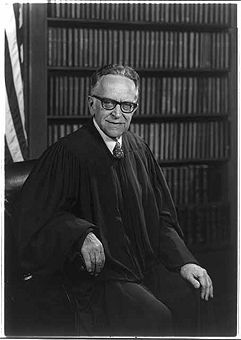Roe v. Wade: Difference between revisions
Pat Palmer (talk | contribs) (More info on the new state of things as of 2022; refs needed) |
Pat Palmer (talk | contribs) mNo edit summary |
||
| Line 9: | Line 9: | ||
Abortion-related cases that have reached the Supreme Court since Roe include [[Webster v. Reproductive Health Services]] (1989), [[Planned Parenthood v. Casey]] (1992), [[Stenberg v. Carhart]] (2000) and [[Gonzales v. Carhart]] (2003). The nominations to the Supreme Court in the presidential term of [[Donald Trump]] are widely considered to be the deciding factor in the overturning of the 1973 decision in 2022. | Abortion-related cases that have reached the Supreme Court since Roe include [[Webster v. Reproductive Health Services]] (1989), [[Planned Parenthood v. Casey]] (1992), [[Stenberg v. Carhart]] (2000) and [[Gonzales v. Carhart]] (2003). The nominations to the Supreme Court in the presidential term of [[Donald Trump]] are widely considered to be the deciding factor in the overturning of the 1973 decision in 2022. | ||
As of 2022, the legality of abortion in the United States is left up to the individual states. About half the states are expected to prohibit abortion, some without even protections for the life of the mother. Several states, especially on the East and West coasts, are expected to enact laws protecting the right to abortion. In the country overall, well more than half the population, in polls, favors the right of a woman to choose whether to bear a child or not. | As of 2022, the legality of abortion in the United States is left up to the individual states. About half the states are expected to prohibit abortion, some without even protections for the life of the mother or allowing it in cases of rape of incest. Several states, especially on the East and West coasts, are expected to enact laws protecting the right to abortion. In the country overall, well more than half the population, in polls, favors the right of a woman to choose whether to bear a child or not. | ||
== References == | == References == | ||
<references /> | <references /> | ||
Revision as of 10:24, 25 June 2022
Roe v. Wade, 441 US 113 (1973), is a United States Supreme Court decision that overturned most state laws outlawing abortion, as it found them to be in violation of the constitutional right to privacy that the Court found in the Due Process Clause of the Fourteenth Amendment. Justice Harry Blackmun, a Richard Nixon apointee, was the author of the majority opinion, with multiple concurrences written by other justices. Byron White and William Rehnquist dissented from the decision and wrote separate opinions.
The plaintiff, whose privacy was masked as 'Jane Roe,' was Norma L. McCorvey, a pregnant Texan woman who claimed to have become pregnant as the result of rape. There were co-plaintiffs too: a "childless married couple (the Does), the wife not being pregnant, separately attacked the laws, basing alleged injury on the future possibilities of contraceptive failure, pregnancy, unpreparedness for parenthood, and impairment of the wife's health".[1] The defendant, Henry Wade, was the District Attorney of Dallas County and represented the State of Texas. McCorvey is now a pro-life activist.
The practical consequences of the plaintiff's victory mean that abortion in the United States is legal until the point at which a fetus becomes viable - set in the court at a maximum of twenty-eight weeks.
Abortion-related cases that have reached the Supreme Court since Roe include Webster v. Reproductive Health Services (1989), Planned Parenthood v. Casey (1992), Stenberg v. Carhart (2000) and Gonzales v. Carhart (2003). The nominations to the Supreme Court in the presidential term of Donald Trump are widely considered to be the deciding factor in the overturning of the 1973 decision in 2022.
As of 2022, the legality of abortion in the United States is left up to the individual states. About half the states are expected to prohibit abortion, some without even protections for the life of the mother or allowing it in cases of rape of incest. Several states, especially on the East and West coasts, are expected to enact laws protecting the right to abortion. In the country overall, well more than half the population, in polls, favors the right of a woman to choose whether to bear a child or not.
References
- ↑ Mr Justice Blackmun's majority opinion
